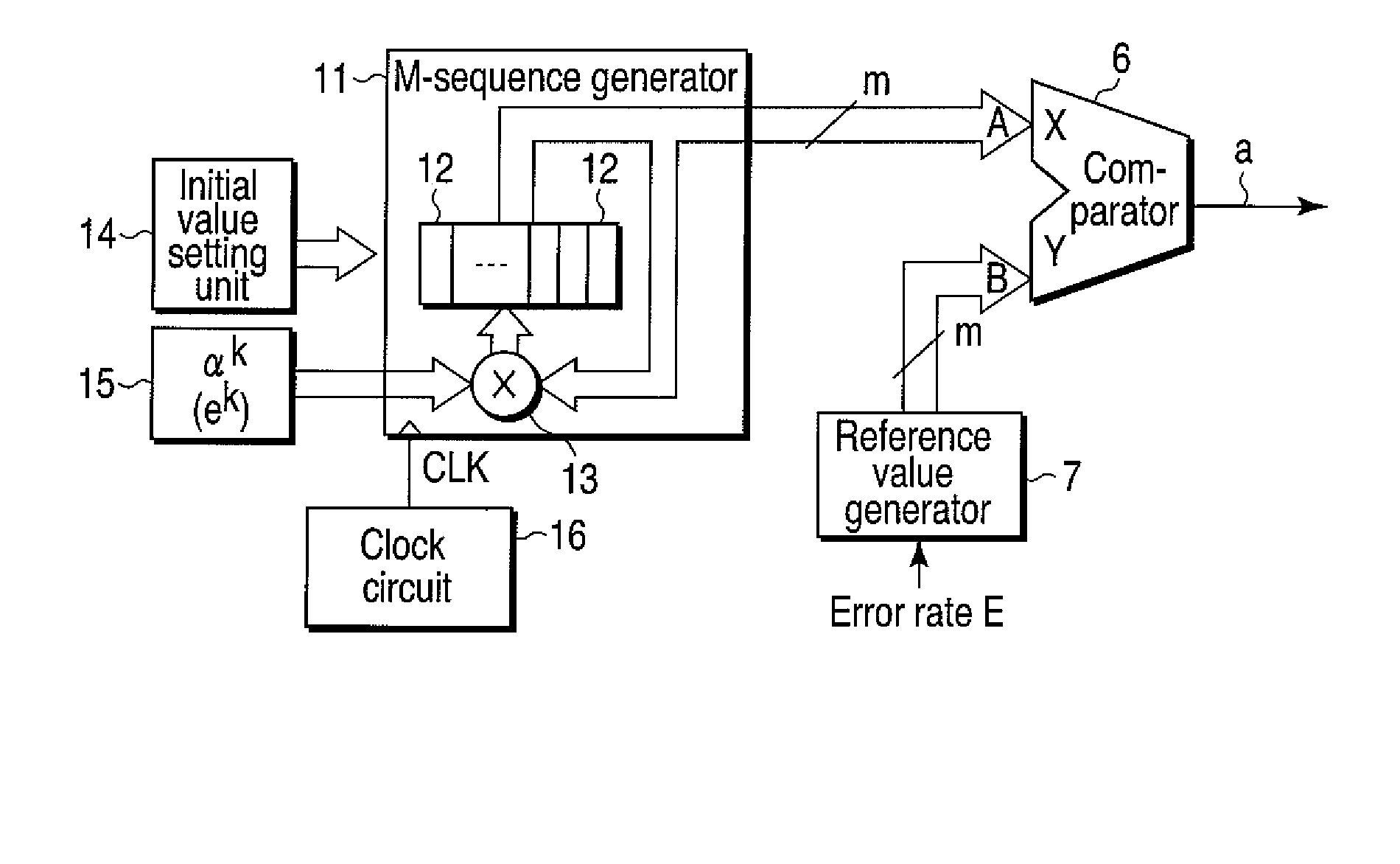M-sequence generator, providing method thereof, and random error generating device in which m-sequence generator is used
a random error generating device and msequence generator technology, applied in multiplex communication, computation using denominational number representation, instruments, etc., can solve the problem that the period of the periodic sequence cannot meet the need, the randomness of the bits supplied in parallel from the registers can be further improved, and the possibility of continuing the same error bit over the plural clocks high possibility
- Summary
- Abstract
- Description
- Claims
- Application Information
AI Technical Summary
Benefits of technology
Problems solved by technology
Method used
Image
Examples
first embodiment
[0161]FIG. 1 is a schematic configuration diagram of a random error generating device in which an M-sequence generator according to a first embodiment of the invention is incorporated.
[0162]In FIG. 1, the same component as the conventional random error generating device of FIG. 15 is denoted by the same numeral, and the overlapping description is omitted.
[0163]An M (maximum length periodic)-sequence generator 11 includes m (m is a positive integer which is 2 or more) registers 12 and a Galois field multiplying unit 13.
[0164]An initial value setting unit 14 sets a one-bit initial value of nonzero constituting a pseudo-random number to each of 0-th to (m-1)-th registers 12 in starting up the M-sequence generator 11.
[0165]A specified power value setting unit 15 applies a specified power value αk to one end of the Galois field multiplying unit 13. The specified power value αk is a primitive element α to the power of specified power k, and the primitive element α is one of roots of an m-...
second embodiment
[0217]FIG. 8 is a flowchart illustrating a method for providing the M-sequence generator of FIGS. 6 and 7 according to a second embodiment of the invention.
[0218]In Step S1, the number m (m is a positive integer) of registers 12 used is selectively set.
[0219]Specifically, referring to list tables of FIGS. 9 and 10, the number m of registers is set to a value that is a prime number and a value that becomes a Mersenne prime number in which the maximum length period (2m-1) is a prime number.
[0220]Specifically one of 12 numbers “2, 3, 5, 7, 13, 17, 19, 31, 61, 89, 107, and 127” satisfying both the “prime number” and “Mersenne prime number” is selected.
[0221]The number m (order) of registers in which the plural primitive polynomials p(x) of the pentanomial having the relatively large number of terms can be realized by the two-element Galois extension field GF (2m) is selected.
[0222]In the example, m=13 is selectively set.
[0223]Then the plural m-order primitive polynomials p(x) in the two...
third embodiment
[0242]In an M-sequence generator according to a third embodiment of the invention, when one of the roots of the polynomial having the large number of terms in the plural polynomials of the two-element Galois extension field GF (2m) in which the number m (m is a positive integer which is 2 or more) of registers 12 is set to the order m is not the element α but an element e, the period of the periodic sequence {(α1k), (α2k), (α3k), . . . } in which the specified power value (ek) of the element e of at least 2 (k≧2) falls within the maximum length period (2m-1).
[0243]In the M-sequence generator of the third embodiment, the adopted polynomial (generating polynomial) is not limited to the primitive polynomial p(x).
[0244]Accordingly, the period of the bit data actually supplied from the M-sequence generator is not always matched with the maximum length period (2m-1).
[0245]However, in the M-sequence generator of the third embodiment, the number m of registers can arbitrarily be set.
PUM
 Login to View More
Login to View More Abstract
Description
Claims
Application Information
 Login to View More
Login to View More - R&D
- Intellectual Property
- Life Sciences
- Materials
- Tech Scout
- Unparalleled Data Quality
- Higher Quality Content
- 60% Fewer Hallucinations
Browse by: Latest US Patents, China's latest patents, Technical Efficacy Thesaurus, Application Domain, Technology Topic, Popular Technical Reports.
© 2025 PatSnap. All rights reserved.Legal|Privacy policy|Modern Slavery Act Transparency Statement|Sitemap|About US| Contact US: help@patsnap.com



